The Coopersville Observer
Friday, July 17, 1931, Pages 1, 3, & 4
MARNE
A Brief History of the Village, Its Churches, School and People. Written by Harry L. Swan of the Observer Staff. One of a Series of Stories to Appear in This Paper
The early history of Ottawa county holds much of interest even to the casual reader, and with this in mind we have decided to prepare a series of stories, with the several villages and communities served by the Observer as a background. We bring these stories to you with the knowledge that some of the data we have obtained may not be entirely accurate as much of our information has been obtained from visits and interviews with the older residents of the communities of which we are writing.
In selecting Marne as the subject of our first story we were prompted by the fact that this village is our nearest neighbor and also that considerable data was already at hand pertaining to those who are at present making it their home.
The village of Marne is one of the oldest in the county, perhaps the oldest of the inland villages, as the means of transportation of the hardy pioneers who were the first to settle our county was the rivers and streams. The forests and prairies at any considerable distance from these streams was practically unknown and remained so many years after the first white men had begun their pilgrimage into this district.
The first white man of whom we can find any record, came to Wright township in 1838, and it was during this year that the township was first surveyed, before that period it having been a part of Tallmadge township. Two years later, or in 1840 there came a number of the pioneers whose names or those of members of their families are familiar to many of our readers. These men were Syphrus Waters, John McLain, Leonard Roberts, Charley Roberts, Edson Fuller, Charles Dumming, Wm. P. Wells, Perley Lawton, Irene Wellman, Jason Parmenter, John Wasson, Charley Buch, Timothy Lillie, Edward Streeter, W. J. Lillibridge, Orren McClure, A. I. Clayton, H. C. McDermott, Wm. Averill, Edward N. Pierce and Albert Parker.
These man came into the virgin forest and by hard work, perseverance and faith in the future of the land which they had chosen for their several homes, wrested for themselves and their families a living and a competence. The work of these men has been carried on by those who have succeeded them until the land has reached its present high state of cultivation.
Some time later there came to what is now the village of Marne a Mr. Ford, a miller, and finding that Sand Creek was a stream with sufficient water and proper fall to make a mill site practical, he accordingly built a dam and erected a saw mill and also a grist mill.
This mill in later years passed into the hands of Ira Cole, and then from him to a succession of others until the dam being carried away by high water and also owing to the fact that the stream had diminished in size until milling by water power was no longer practical, these institutions passed into history.
There was at one time in the early days a woolen mill at Marne, it being equipped with several looms and enjoying a lucrative run of trade.
The building which housed this concern still stands on its original location.
It is upon land owned at that time by Mr. Ford and Enos Morgan that the village now stands, and together with these men many other names are closely interwoven with the history of Marne. We find that Sam Everhardt came there many years ago and established himself in business at his trade, that of a wagon maker; that Wm. Monroe was the harness maker who catered to the needs of the early settlers. That Syphrus Waters, father of Henry Waters for some years ran a saw mill at this point.
In 1849 Lucien A. Cole came to Marne and bought the land which has remained in the family since that time, an interesting incident connected with this history of this family being that Frank Cole, a son, who is now owner of the old home place, sleeps in the bed room where he first saw the light of day. Mr. Cole has added to his holdings, but continues to reside in the old home place around which so many pleasant memories cling.
We are indebted to Dr. Charles Chappel for the facts we derived from a very pleasant visit with this gentleman. Dr. Chappel came with his parents, Mr. and Mrs. Peter H. Chappel, in 1867, being at that time fourteen years of age. When he had reached maturity, he chose the medical profession as his life work and after graduation at Ann Arbor, returned to his old home at Marne, and for 40 years has served the community, traveling through rain and snow, night or day, that wants of the ailing be they rich or poor, might be satisfied. He has given a lifetime to the needs of his community, and now in the sunset of his life s enjoying the fruits of his labor. Peter Chappel, the doctor’s father was for many years justice of the peace at Marne. During the early years of Dr. Chappel’s practice in Marne the community was also served by Doctors Walling and Dayton.
With the coming of more people into the community there followed those who care for the spiritual needs of mankind, the Baptist, Catholic and Methodist churches being identified with the early history of the community. Records show that as early as 1822 the work of the Baptist church was started in this vicinity. At that time a mission was established on the banks of Grand River at what is now Grand Rapids, and in 1867 the Methodist and Baptist churches had both been established and the Baptist church at that time was served by Rev. A. R. Savage. Like all the small town churches these denominations have had their ups and downs. This church after a succession of pastors, who have done their part in bringing the word of God to the residents of Marne, is now served by a pastor from Grand Rapids. The Methodist church at this early date was under the charge of Rev. E. C. Draper, who ministered to the needs of his congregation with all the faithfulness that characterized the preachers of pioneer communities. The Methodist church since that time has been united with the church at Coopersville, Rev. Joseph Tuma being the pastor at this writing.
Much that is of interest is attached to the early history of the Marne Catholic church. In the early forties a number of Irish pioneers were attracted to the township of Wright and Tallmadge, lured by the fertility of the soil and many other advantages. They were among the first settlers of the eastern part of Ottawa county and were men who came seeking advantages which had been denied them at home. Perhaps the hand of destiny guided them to this particular spot, but be that as it may, here they came and here they remained to do their part in writing the history of our neighboring community. How well the succeeded is apparent to any one who may visit the territory they selected for their homes.
They possessed many other qualities besides those necessary to enable them to acquire a competency. They made many sacrifices for posterity. Scarcely had they completed the erection of a dozen log cabins in the woods than they set about the building of a log school and by its side a little temple dedicated to God and His worship.
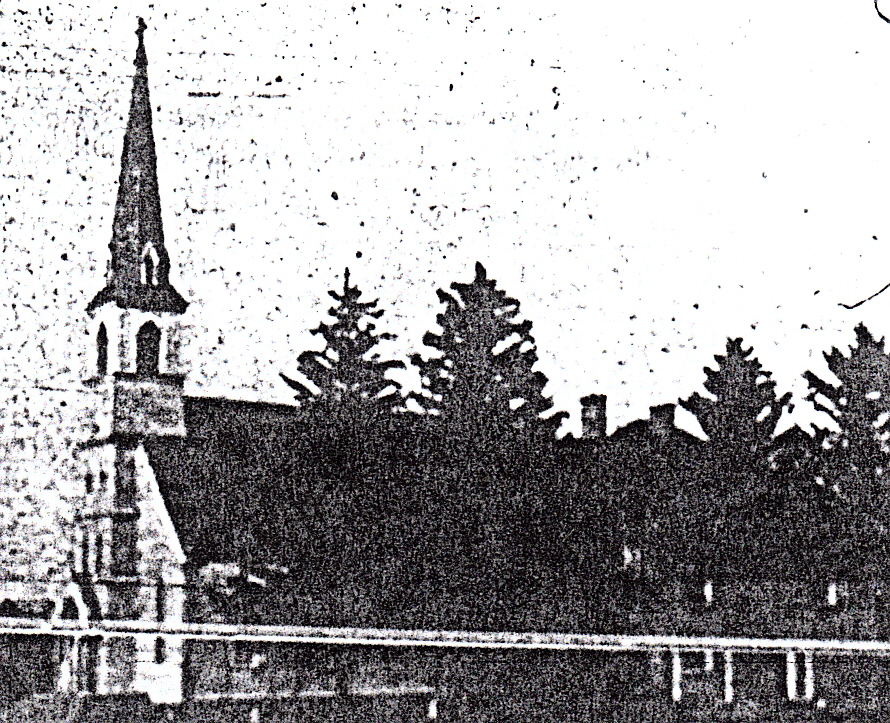
ST. MARY’S CHURCH, MARNE
The first Catholic church was built some distance west of the location of the present edifice. It was a modest frame structure and was at that time and remained for many years the only church in the township of Wright, with the exception of the German Catholic church, which was built at about the same time.
In the year 1877, the congregation having outgrown the old church, a new one was built on a more elaborate scale. The parish was in charge of Rev. T. J. Murphy, then a young man of great personal charm and very popular with all classes. Soon after the completion of this church Father Murphy was called to other fields of endeavor. He was succeeded by the Father Dalton, then Father Caldwell. Following these came Father O’Connor, who by unceasing effort was instrumental in making of the house of worship a beautiful monument to the cause he loved.
Just at the time when it seemed that the priest and congregation could begin enjoyment of their labors, fire destroyed in a few moments the labor of years. But owing to the generosity of the members of the parish and the perseverance and zeal of the pastor, on the ashes of the old was erected the new and present St. Mary’s church. This church has stood through the years and still remains a monument to the untiring efforts of the several pastors in charge.
Following Father O’Conner came Father Mans and then Father Hyland. The present pastor, Father Timothy O’Connell was appointed in September, 1923, and the church today, under his charge is one of beauty, both outside and in. It would be necessary to travel many a mile that you might find a country church whose interior and surroundings would show the loving care and beautiful result of such care that is pictured here—the refined and dignified taste of the exterior, combined with a beautiful and rich simplicity within.
Not only were the spiritual needs of the community in the minds and hearts of the people but the desire that their children might have the necessary education to equip them for their battle of life caused them to plan for the erection of schools. Through the years these were built and replaced as the increase in population made the changes imperative, until the present educational establishment at Marne was built.
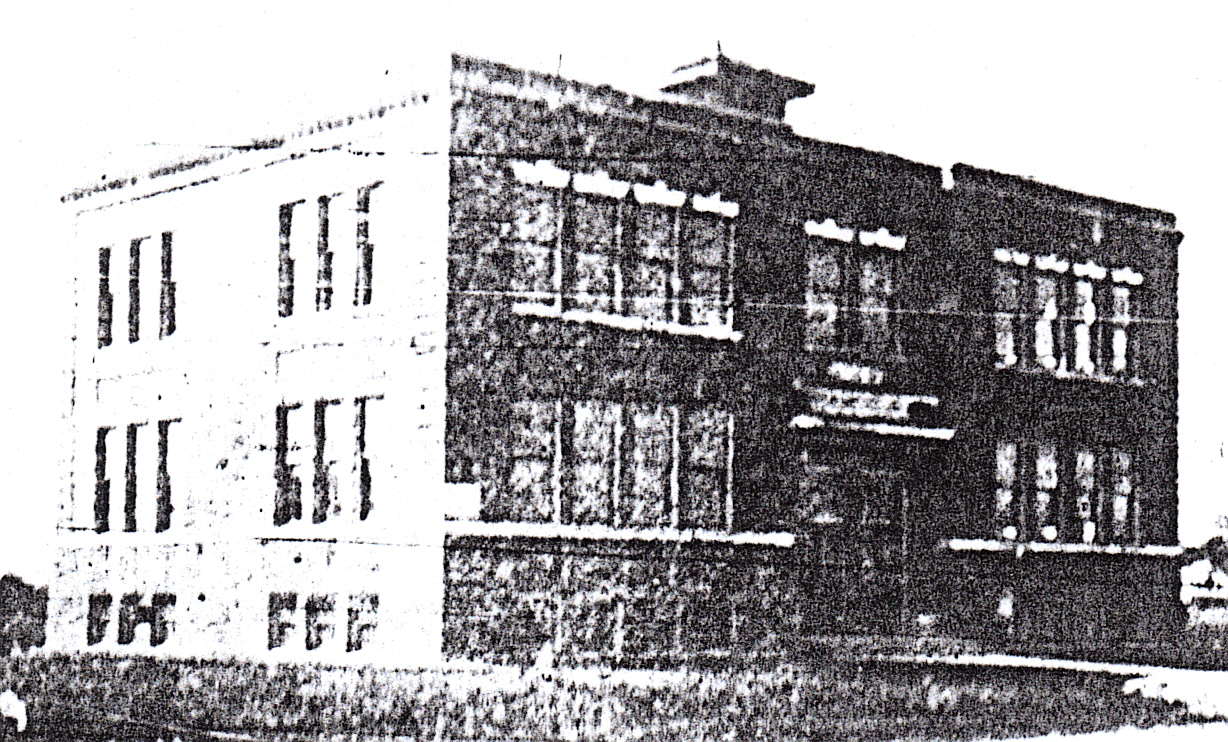
THE MARNE HIGH SCHOOL
The people of Marne and the caretaker of the building, Mr. Adrianse, are very proud, and justly so, of the school. Situated as it is, on the high ground on the eastern part of the village, on the cement highway M-16, its beauty attracts the attention of all who travel this route. The attractiveness of the first view extends an invitation to the lovers of beauty and you are impelled to turn aside and loiter for a moment where nature, guided by the hand of man, gives so lavishly.
A large granite boulder attracts the eye and as you saunter closer that you may read the inscription on the bronze tablet which has been imbedded in the side of this monster stone you read that the playground upon which this monument stands was given to the school by Frank J., Walter A. and Chas. P. Goodenow as a memorial to their sister, Cora M. Goodenow, "Teacher and Friend of Youth." She was a former teacher in the Marne school and by this memorial memory of her and her work will be perpetuated through the years. Several acres are contained in the playground given by these gentlemen and it makes a welcome addition to the already generous allotment of ground occupied by the buildings.
Turning from this you are pleasantly surprised that so much care is taken in the upkeep of the grounds surrounding the buildings. Here have been planted a succession of flowers, cunningly chosen and casually arranged, the whole being so planned that there may be a succession of color throughout the summer. The completed ensemble presents a riot of color, the placing of the shrubbery in strategic points forming a picture that may be carried in your mind long after other duties have taken you on your way.
Upon entering the building you find that the lower floor is occupied by the lower grades, there being liberal quarters for the kindergarten. Separate rooms for the 3rd and 4th grades, the 5th and 6th grades and the 7th and 8th grades. The rooms are generous in size, the fixtures are as comfortable and convenient as it is possible to procure and much effort has been made that every educational advantage possible shall be given the pupils.
The second floor is given over to the housing of the high school classes. The main assembly room has seating space for sixty-six pupils, and along the walls are arranged cases filled with the most up-to-date reference books. The class rooms are so arranged to facilitate the movement of the classes, with the comfort of the pupils holding first place in the minds of the designers.
The heating of the building is accomplished by a new type Heggie Simplex boiler with a capacity in excess of the amount of radiation needed to thoroughly heat the building. The building has its own water pressure system, the power being furnished by electricity, the motor operating automatically. In the basement, which is of full size, provision has been made for the installing of lavatories for both the girls and boys, large daylighted rooms having been set aside for that purpose. Every facility for the comfort of the pupils has been provided for or planned.
In addition to the landscaping of the grounds, playground equipment has been provided for the amusement of the younger as well as the older pupils. Swings, slides and other features take care of the younger generation while a cement tennis court provides for the amusement of the older boys and girls.
The teachers of the school during the year just closed were: M. H. Lymburner, superintendent; Guy H. Carr, principal; Grace Oosterheert, high school teacher; Gray Ragen, 7th and 8th grades; Gertrude Molloy, 5th and 6th grades; Rosemary Burke, kindergarten. The members of the school board are Levi Van Tuyl, president; Charles P. Goodenow, secretary; Edward Riemersma, treasurer; Mrs. Eleanor Sheldon and Wm. H. Yeomans.
The courtesy of Mr. Adrianse in showing us through the grounds and building is much appreciated and we are very glad to have had the opportunity of paying a visit to the institution.
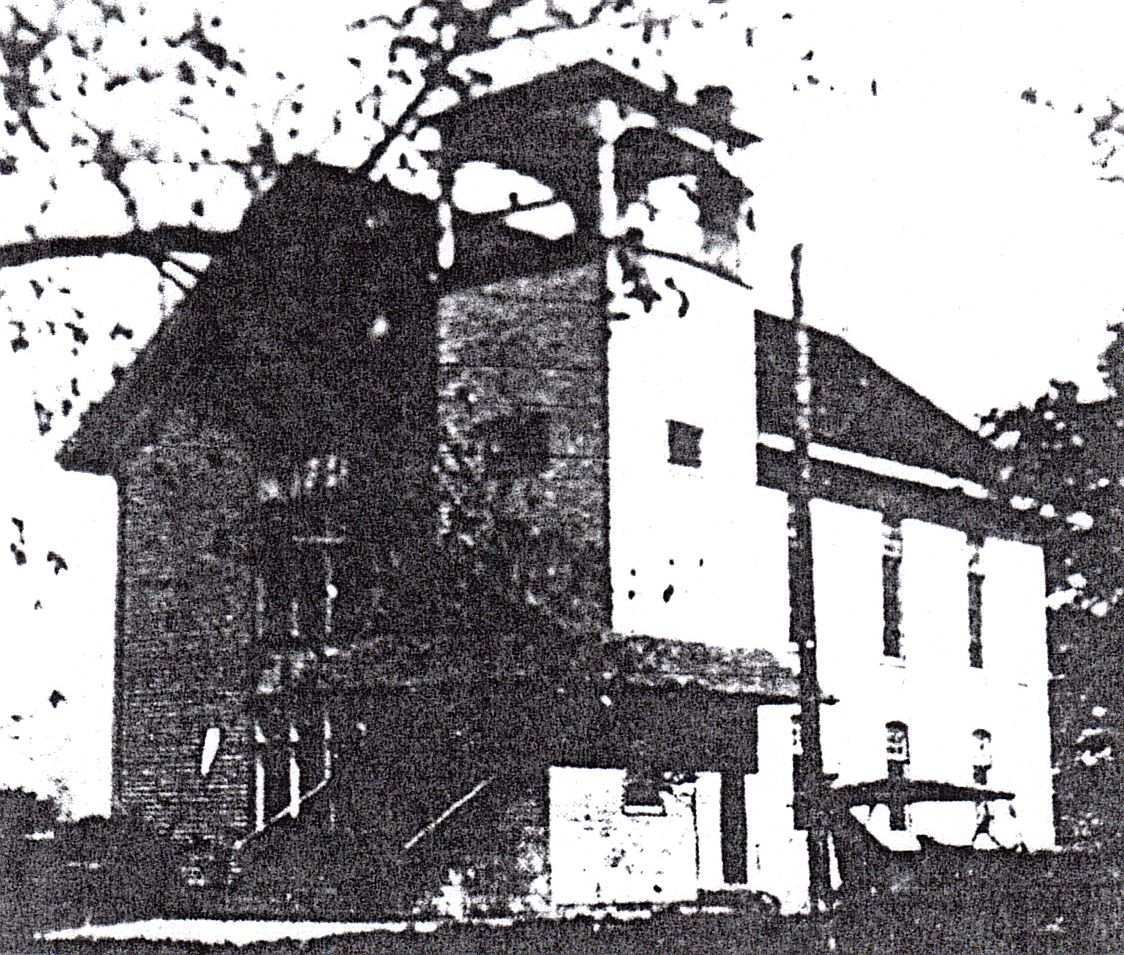
MARNE METHODIST CHURCH
This brings us down to the merchants who are serving the public in this enterprising village. They are perhaps as genial, up-to-date and enterprising a collection of people who earn their daily bread by serving the wants of others as could be found anywhere. Wherever we called we were treated with genuine courtesy and every effort was made to help us obtain the information we wanted. If we misstate any of the facts you may be sure that is due to our inattention and not the fault of the gentlemen who were so kind to us.
The banking needs of the village of Marne are capably taken care of by the Berlin State Bank, an institution which was established in 1910 with capitalization of $20,000.00. The first president of the bank was George Bevins, his son Elton Bevins acting as cashier.
Two year later Mr. Goodenow became cashier, which position he still holds. The present officers of the bank are Frank Goodenow, president; Allen C. Butterworth, vice president; Chas. P. Goodenow, cashier and Wm. Ter Avest, assistant cashier. The bank, throughout its existence has been strong, safe and reliable, ever ready and willing to take its part in the upbuilding of the community which it serves. The bank has resources, according to their latest statement just published, of $216,200. They carry a surplus fund of $6,500 and undivided profits of $4,425. Their deposits are approximately $217,000.
The Goodenows, who have been associated with the bank practically since its organization are of good pioneer stock, the sons of early and highly respected farmers of Wright township. Charles P. Goodenow is now filling the position of supervisor of the township and both he and his brother Frank, president of the bank are progressive citizens and continual boosters for their village.
The character of the management and directorate of this bank allows it to occupy a rank of high order among the small town financial institutions of Western Michigan.
Another enterprise in which Mr. Chas. P. Goodenow is actively interested and one of the prime movers is the Ottawa and West Kent Agricultural Society, an organization which this year is staging the seventy-sixth annual renewal of their fair. This enterprise which originally held the fair at Lamont, later purchasing the ground upon which are now located the buildings and race track at Marne, has continued to furnish amusement to the people of Ottawa county, carrying the burden of financing the project through the lean years as well as the fat, until at this time they are the only organization of this nature in the county. They have given the people what they wanted in the way of good clean amusement, horse racing of a high order and agricultural and floral exhibits second to none.
The association is the owner of thirty acres of ground with a conservative valuation of $3,000, upon which have been erected building calling for the expenditure of in the neighborhood of $15,000. The total of the premiums which will be paid this year will amount to about $2,000, in addition to which are the purses for the horse racing and the many prizes which have been donated by firms and individuals to stimulate the showing of horticultural and agricultural products.
Hugo Freidrich is president of the society; L. J. Hinken, vice president; Ralph Burrell, treasurer; Chas. P. Goodenow, secretary and Mrs. Harvey Walcott, assistant secretary. The fair this year will be held on September 22, 23, 24 and 25 and immense crowds are expected this year and will be provided for. It being the only fair within the radius of a good many miles is expected to stimulate the attendance to a marked degree.
The largest business house in Marne is that of Burch & Co., the members of the firm being George and Cleve Burch. The store is one that would be a credit to a city many times the size of Marne and is planned on a scale that one does not expect to find in a village like Marne. The store is wide, as wide as two ordinary business houses, with the entire front of the building being composed of glass. The arrangement of the store allows for a large amount of open counter space, all filled with attractive displays of goods which cannot fail to create a desire in the buyers mind.
Mr. Burch has the ability to properly display his wares to the best advantage and makes it his business to see that the open tables in the center of the store, as well as the shelving at the sides are always filled with clean, new stock. He ha for a motto "always clean, fresh and wholesome," and this he adheres to strictly.
Burch & Co. built this fine, modern store about eight years ago and they report that since its construction their business has shown a steady growth. Mr. Burch states that "my overhead is light compared to that of the city stores and I find it very easy to meet city and chain competition."
In this store will be found a wide variety of strictly saleable goods and the line of groceries, dry goods and meats and in regard to the stock, Mr. Burch states "I believe that the best at the lowest price is none too good for my trade." The Burch & Co. firm are boosters for their town and make this claim: "This is a fine district, the proximity to Grand Rapids giving our farmers and gardeners a great wholesale and retail market and more city people are realizing that an acre and a garden near such a village is ideal for home life. I am satisfied that I am located in a district with a future."
Like many other active minded Western Michigan men, Mr. Burch is a native of the township of Tallmadge. The grandfather, Lewis Burch walked from Detroit to Tallmadge in the old pioneer days and on the farm of his father, George E. Burch, the future merchant had a varied and on the whole an educational training. At an early age he began trading on the Grand Rapids market, driving during the night to that trading center with loads of strawberries, raspberries, peaches and apples. Only a farmer who keeps posted on values and knows market conditions can sell at a profit when fruits are plentiful. There is no better training for the future merchant than contact with the keen minded traders who represent the big commission houses and the experience gained by Mr. Burch in his early ventures have proven of inestimable value to him in his present merchandising.
Mr. Burch left the old home twenty-five years ago and established the business he now conducts in Marne.
The firm of Burrell & Goodenow, dealers in hardware, boots and shoes and one of the better lines of farming implements, is another of the progressive firms doing business in Marne. Both men have grown up in the community. Mr. Burrell came from Wisconsin when but fourteen years of age and served his apprenticeship on a Tallmadge farm. The farm was one of 160 acres and fertile and here Mr. Burrell learned that modern business practices go hand in hand with good and successful farming.
The business now conducted by Burrell & Goodenow was formerly owned by Joseph Raymond, and after his death its management was assumed by the daughter. Mr. Burrell had at one time casually remarked that he was rather in the notion of purchasing the Raymond interests but nothing definite was done at this time. Some time later, however, Miss Raymond called him in consultation and the deal was put over. Thus Mr. Burrell became identified with the business life of the community and he has carried on through the years that have followed, adding to his long list of friends and holding his position as one of the leaders in the movement for the betterment of the community. He assumed charge of the business about twenty years ago.
The association of Messrs. Burrell and Goodenow in the business have been a close parallel to the Damon and Pythias friendship of old. They have, as all well matched teams have done, pulled together at all times. Their business ideas are on a par and this has been one of the main factors in their business success. To use the words of Mr. Burrell himself in this connection: "When I decided to invite Mr. Goodenow to become my partner in the business some twelve years ago, I did so because I knew that he was a ‘square shooter’ and a reliable man. During our business connection we have never had a disagreement and we both have the same theory regarding business—be square."
Some years ago a fire caused considerable loss to the firm, an insurance policy of $3,500 which they carried not nearly compensating them for the goods which were destroyed. They took their losses with a smile and came back to their former standard with a rush and have continued to progress with the trend of the times as every wide awake merchant must do to be successful.
The firm own their own store building and are always ready and willing to go more than half way in the service of their large and growing list of clients and friends.
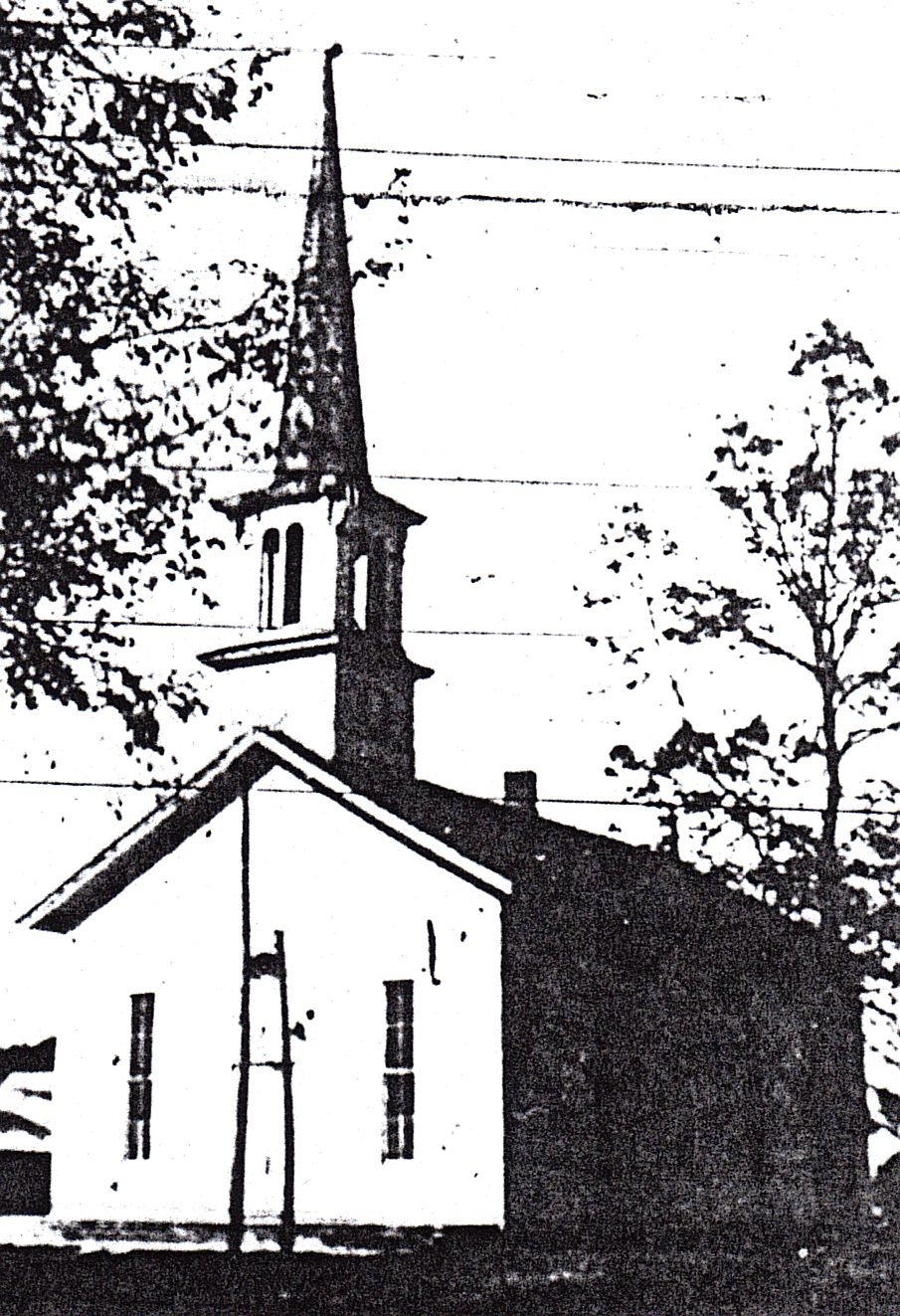
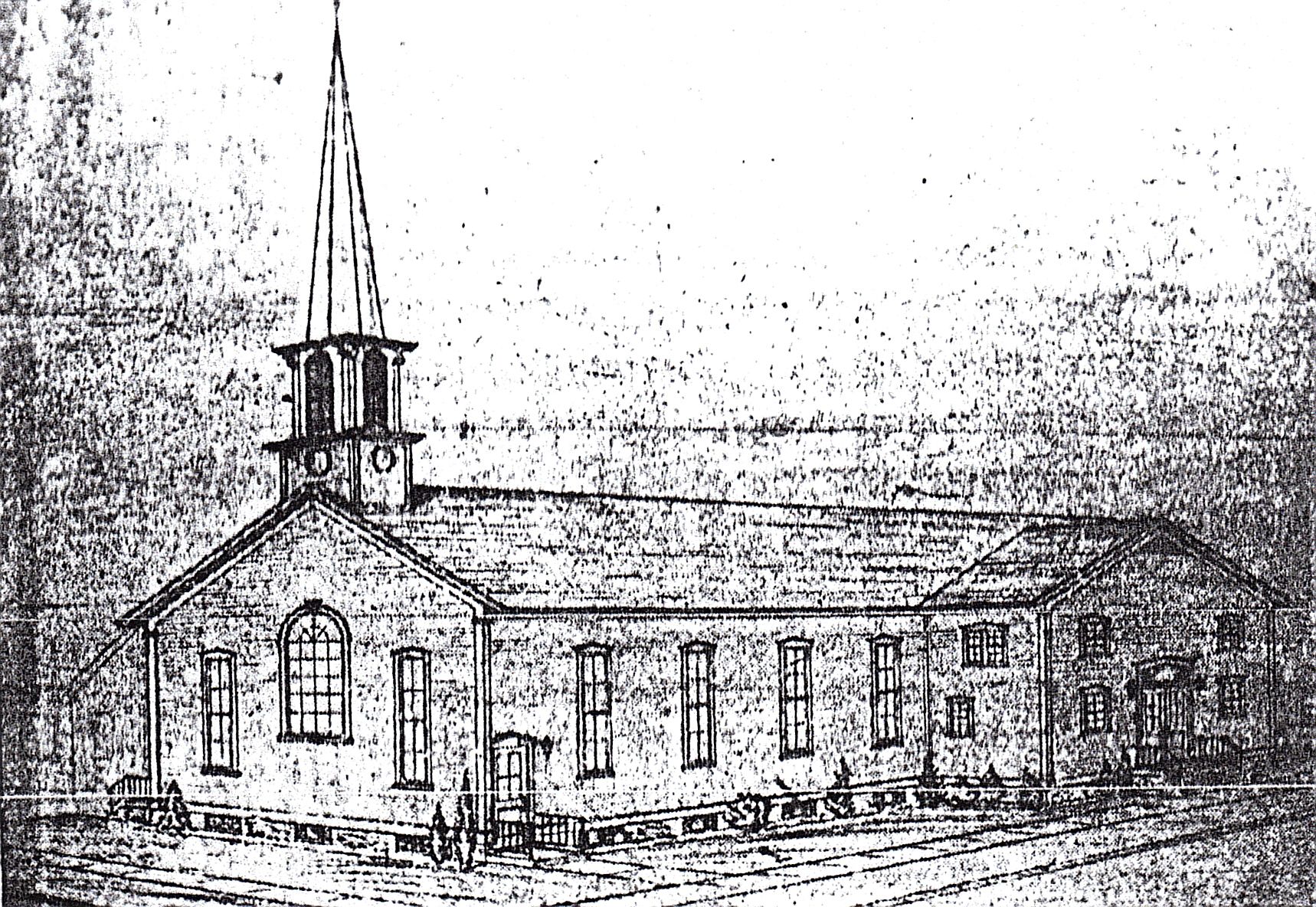
MARNE BAPTIST CHURCH
The newest addition to the business life of the village of Marne is A. B. Ayers, who early in April came to the village and purchased the business and good will of E. F. Lardie, who with his wife had been conducting a general merchandise store.
The store of the A. B. Ayers Co., is located on the most prominent corner of the village, carries a large and varied stock of goods, and under the ownership of Mr. Ayers will perpetuate the traditions established by Mr. Lardie.
Mr. Ayers came to Marne from Holland, and while he was at that time unfamiliar with the routine of merchandising, he has studied his trade and merchandising conditions as applied to Marne, and given time, will show that aggressiveness and good business judgment will stand for success in any line. Mr. Ayers is a firm believer in the power of printers ink in carrying his business message to the people in his trade territory and at fairly regular intervals uses the mails of Uncle Sam to tell his old and his prospective customers what he has for sale and why they should buy it.
At the time of taking over the business, Mr. Ayers spent a lot of time and considerable money in thoroughly renovating the store, rearranging the shelves and their contents and now has as neat a place of business as could be wished for.
C. G. Schurr, proprietor of Marne’s drug store, is a very likeable personage and his pleasing personality spells the reason for the popularity of his establishment. Mr. Schurr is a graduate pharmacist, having taken his degree at the Warner School of Pharmacy at Sandusky. This school is a small one but is under the management of a trained pharmacist whose pupils have the reputation of winning out with regularity in the state examinations. Here, in addition to the regular line of drugs and medicines you will find ice cream and cold drinks as well as toilet accessories and stationery.
In addition to the drug business, Mr. Schurr represents Uncle Sam in Marne and the postoffice is located in the store. He has been serving in the capacity of Postmaster for the past five years and the patrons of the postoffice there are well satisfied with his administration of affairs. Two rural mail routes center in Marne, one of which, served by Carrier Garter, being 34 miles in length and the other, handled by Carrier Walcott, is 32 miles.
Mr. Schurr came to Marne from Grand Rapids, but in the years he has been a resident has become a thoroughly naturalized and acclimated Marne-ite.
Just off the main street of Marne is located a blacksmith shop, owned and operated by Henry Schall, who for over twenty-six years has taken care of the needs of the citizens of that village and the surrounding territory in the way of blacksmithing. Mr. Schall has spent many years at the forge and anvil and before the automobile crowded the horse drawn vehicles off our highways, can remember when the shoeing of twenty-five or more horses a day was not uncommon. Mr. Schall is of the opinion that the horses will be here many years after the horse shoers have passed on, as at the present time there are no apprentices in the blacksmith shops and with no one learning the trade there will be none to carry on the work when those who are now working at the trade have laid aside their tools.
The hungry engines of the creations of Henry Ford and General Motors are cheerfully taken care of at two popular places in Marne, those of James Owen, who dispenses gas and oil at the outskirts of the village, on Grand Rapids-Grand Haven highway and the establishment of Clarence E. Eubank on the main street of Marne. Here also you may have the ill and ailments of your car given first aid treatment and be happy in the knowledge that you have taken the "critter" to a real hospital.
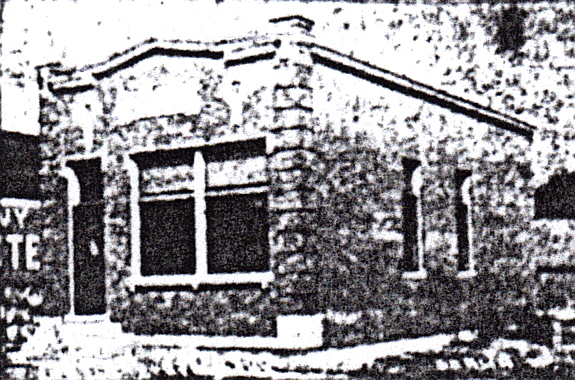
MARNE BANK
Another business institution which draws its trade from a territory reaching for miles around the village is that of Blink Bros., Bert and Harry, who twenty-one years ago came to Marne from Grand Rapids and bought the elevator, at that time operating under the ownership of Henry Zwers.
Under their careful management and perhaps due to their never varying policy of fair treatment and smiling service, the business has prospered and they have enjoyed a steadily increasing volume of business until at this time their establishment is an important factor in the civic life of the community.
The business of Blink Bros., is in a way an outgrowth of the old time water mills that dotted the banks of Sand Creek and ground the grain for the farmers of that community. These gentlemen not only conduct a reliable elevator service, including the buying of grain and all the side lines connected with this activity, but they are also dealers in coal.
The firm deals extensively in lumber and building materials of all kinds, their trade territory in these necessities covering a wide area. Many of the finest homes and other building in the community are built of materials purchased of Blink Bros.
Every community must have their handy man and this crying need is filled in Marne by Frank Cook who has earned for himself the title of "Hurry-up Frank" among his fellow townspeople.
Mr. Cook came into the community a about seventeen years ago and associated himself with Wm. Stadt, now of Grand Rapids, in the laying of tin roofs. This industry he followed for about three years, after which he purchased the shop where he is now located and has been Marne’s "jack of all trades" since that time.
Mr. Cook has a unique shop and is thorough mechanic. If the farmer’s clock is ailing, take it to Cook. Should the wrist watch of the village maiden fail to perform in a proper manner, take it to Cook. If the umbrella fails to open Frank will remedy the difficulty and when the shoes of any family need attention, take them to him. Your mechanical troubles can all be remedied by Mr. Cook and after his years of service to the people of Marne he has become a community necessity, as indispensable to the people as the grocery man or the meat man.
Another business house that is popular with the people of the community is the Blue Bird Shop, conducted by Mr. and Mrs. Hugh McIntyre, who have combined the idea of a delicatessen store with the sale of ice cream and soft drinks. Here also may be purchased sandwiches and drinks of all kinds.
Mr. and Mrs. McIntyre are former residents of Grand Rapids and came to Marne a little over a year ago to establish the business they are now conducting. By keeping their establishment neat and clean and anticipating the needs of their prospective customers they have firmly established themselves in the business as well as the social life of the village.
The establishment of Edward Butcher furnishes an opportunity for those who may have a few idle moments to indulge in a friendly game of pool or billiards and his place has proven popular with those who may care to indulge in this recreation, especially when the long winter evening are with us.
The tonsorial needs of Marne are very capably handled by Martin Butcher, a son of Edward Butcher and his host of friends will testify that here you may obtain a smooth shave, or an artistic hair cut.
In the Red and Black restaurant, Marne has an eating place that has grown more and more popular with those who find it necessary to take their meals away from home. Here you may purchase clean food, cooked by Mrs. Hannah Lewis just as it would be cooked in your own home.
The name Red and Black chosen the fact that the hair of Mrs. Lewis, the proprietor is red and that of ______ ______ ______ black.
In the decoration of the eating house the colors of red and black have been used on tables and walls, which lends a cheery atmosphere to the room. Mrs. Lewis has been in charge there since January and in this short time has proven to the trade that her cooking is second to none.
A building that attracts the attention of visitors to the village of Marne is the home of Centennial Lodge, I. O. O. F., which stands as a monument to the energy and faith of the members and carried to completion the task of building this lodge home. The members are very proud of what they have accomplished which is as it should be. It would take much searching to find a lodge home as fine as this in a village of the population of Marne. The lodge has been in existence for fifty-five years, its organization having taken place in Centennial year—1876—and it is for this reason that the name as given was chosen.
Berlin Lodge No. 248, F. & A. M. was organized many years ago and numbered among its members are many of the prominent residents of Wright and adjoining townships. More than one hundred and fifty names are upon the roster of the lodge, and while many of the members have migrated to Grand Rapids for business reasons, the great majority retain their membership at Marne. In fact it is not unusual for the Grand Rapids lodges to be requested to waive jurisdiction by men who prefer to be connected with this old and popular lodge.
The lodge rooms of the order are located over the drug store and meetings are held at regular intervals at which a good attendance is enjoyed. The lodge is prosperous financially and its business and social affairs are taken care of by well chosen officers.
The following persons were charter members: H.A. Norton, Wm. L. Norton, R. B. McCulloch, Abram Biglow, Elisha Martin, Charles L. Lawton, Job. H. Trefry, Isaac Walker, Ezra Halling, John T. Haley, Benj. S. Whitman, John T. Dayton, Wilson Millard, Benj. F. Norton, Joseph Sever, Alvin Decker. The first regular meeting was held Tuesday, March 3rd, A. D. 1868, and the officers were: H. A. Norton, W. M.; W. L. Norton, S. W.; R. B. McCulloch, J. W.; J. H. Trefry, Treas.; Charles L. Lawton, Sec.; A. Biglow, S. D.; E. Martin, J.D.; John T. Haley, Tyler.
Berlin Chapter, No. 216, Order of Eastern Star is also a prosperous and popular society, boasting of a membership of in the neighborhood of eighty, all of whom are devoted to the objects and traditions of the order.
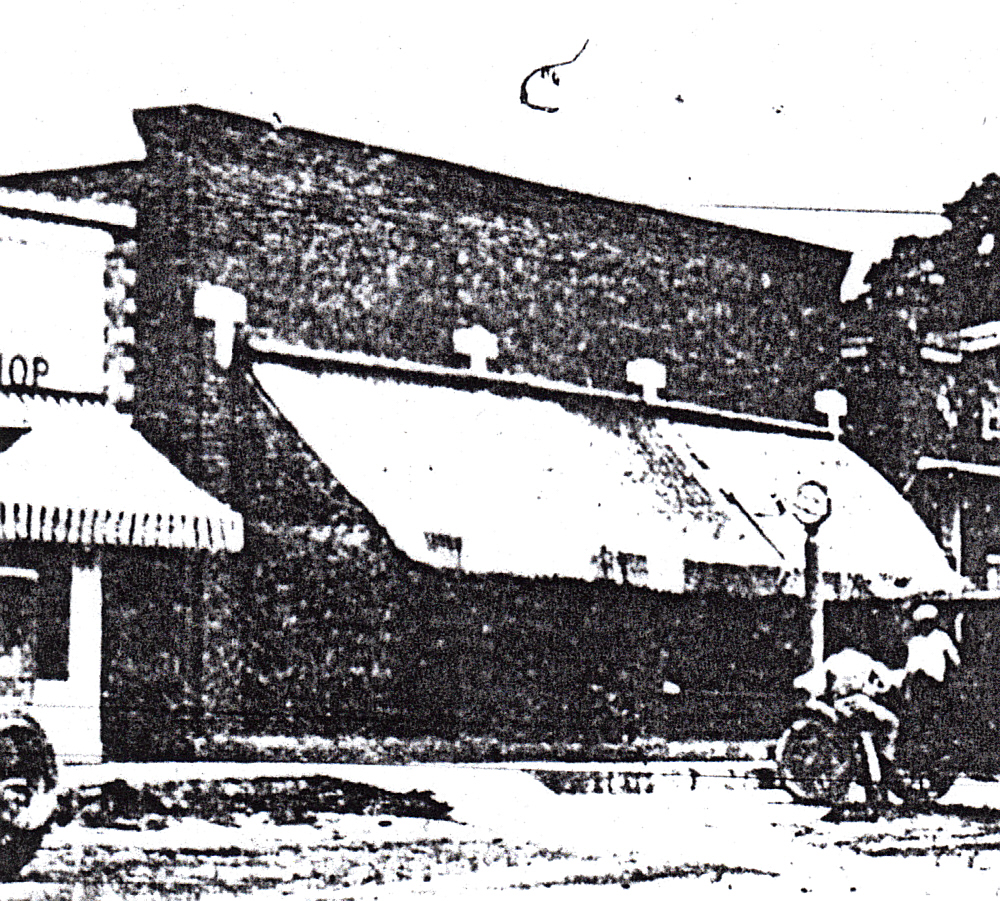
BURCH & CO. STORE
Dr. J. J. Miller serves the medical needs of the village of Marne, his practice covering a territory many miles in extent. He is a product of the community having been born on a farm about four miles south of Marne. After his graduation from the public schools Mr. Miller having decided that the medical profession would be his vocation, accordingly enrolled as a student at the Detroit Medical College from which institution he was graduated with honors in 1915(?).
When he had received his diploma Dr. Miller became a member of the medical staff at Blodgett Memorial hospital in Grand Rapids, being connected with that institution for a considerable length of time. After his internship at the hospital, Dr. Miller served for some time at the Loomis Sanitarium in New York, where he specialized in the treatment of tuberculosis.
About this time the United States entered the World War and the doctor entered the service of his country, being connected with the medical corps until the close of the war, when he came to Marne and started the practice which has grown with the years as has the popularity of the physician.
Dr. Miller’s office is located in what was formerly the interurban station, which he purchased for that purpose and has it completely remodeled. He has a complete hospital on a miniature scale, his building being equipped with all the necessary equipment for the performance of minor operations. The principal part of the work along that line which the doctor handles here is the removal of tonsils. He has divided the building into several rooms, such as his office, reception room, consultation room, etc., as well as a ward wherein are installed two beds for the care and comfort of his patients.
Marne should be very proud of Dr. Miller, as he has given much time and thought as well as having incurred considerable expense in giving the village this fine little hospital.
Dr. H. Elzinga, veterinary surgeon, is a graduate of Grand Rapids veterinary College and after his graduation from that school in 1906, started his practice in Grand Rapids. Here he remained until the use of automobiles had made such inroads into his practice that he decided to migrate to Marne, which he did in 1917.
As Dr. Elzinga laughingly mentioned, the title of veterinary surgeon was seldom heard in the old days, the men of his profession being most generally called "horse doctors." With the exodus of the horse drawn vehicle from the highways and village streets the nature of the doctor’s practice changed and he says that not over twenty-five per cent of his practice today is furnished by horses. The other seventy-five per cent is confined to cattle, hogs and sheep, and a very large percentage of this practice is given over the work of vaccination. The doctor has a very beautiful home in the village, and his practice among the many dairy herds in his vicinity keeps him busy the greater part of the time.